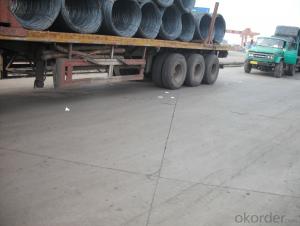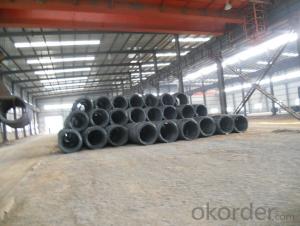Hot Rolled Wire Rods in Material Grade SAE1008
- Loading Port:
- Tianjin
- Payment Terms:
- TT OR LC
- Min Order Qty:
- 25 m.t.
- Supply Capability:
- 20000 m.t./month
OKorder Service Pledge
OKorder Financial Service
You Might Also Like
Specification
Grade: SAE1008 Standard: ASTM
Diameter: 5.5mm, 6.5mm, 7mm, 8mm, 9mm, 10mm, 11mm, 12mm
Alloy or Not: Alloy
Technique: Hot Rolled Place of Origin: China Mainland
Chemical Composition:
Please kindly find our chemistry of our material based on SAE1008 as below for your reference:
Grade | Chemical Composition (%) | |||||
C | Mn | S | P | Si | B | |
SAE1008 | 0.10max | 0.30-0.50 | 0.050max | 0.040max | 0.30max | 0.0008min |
Mechanical properties | ||||||
Yield strength(N/mm2) | Tensile strength(N/mm2) | Elongation (%) | ||||
≥195 | 350-380 | ≥32 | ||||
Usage and Applications of SAE1008 Steel Wire Rod:
After hot-rolled the products shaped into coil and delivery as finished product, including round, square,rectangular, hexagonal and so on. Since most of the products are round, it is generally called wire rod. Carbon steel wire rod is widely used in construction and manufacturing. Carbon steel wire rod is mainly used for reinforcement of reinforced concrete and welded structure or reprocessed (roberts , nail, etc.) materials, especially used to produce wire drawing, welding electrode, nails, spring, electronic, precise machinery parts and so on.
Packaging & Delivery of SAE1008 Steel Wire Rod:
Packaging Detail: products are packed in coil and then shipped by container or bulk vessel
Each coil weight: About 2.05MT
Delivery Detail: within 45 days after received deposit or LC.
Label: to be specified by customer, generally, each bundle has 1-2 labels
Trade terms: FOB, CFR, CIF
FAQ:
Q1: How soon can we receive the product after purchasement?
A1: Within three days of placing an order, we will begin production. The specific shipping date is dependent upon international and government factors, but is typically one month.
Q2: How do you guarantee the quality of our products?
A2: We have established an advanced quality management system which conducts strict quality tests at every step, from raw materials to the final product. At the same time, we provide extensive follow-up service assurances as required.
Q3: Why buy Materials & Equipment from OKorder.com?
A3: All products offered by OKorder.com are carefully selected from China's most reliable manufacturing enterprises. Through its ISO certifications, OKorder.com adheres to the highest standards and a commitment to supply chain safety and customer satisfaction.
Images of SAE1008 Steel Wire Rod


- Q: What are the different types of steel wire rod coating thicknesses?
- There are several different types of steel wire rod coating thicknesses available depending on the specific application and requirements. Some common coating thicknesses include: 1. Light Coating: This type of coating has a thin layer of protective material applied to the steel wire rod. It provides minimal protection against corrosion and is suitable for applications where the wire rod will not be exposed to harsh environments or extreme conditions. 2. Medium Coating: Medium coating thickness provides a moderate level of protection against corrosion and other environmental factors. It is thicker than a light coating and is commonly used in applications where the wire rod may be exposed to moderate levels of moisture, chemicals, or abrasion. 3. Heavy Coating: Heavy coating is a thicker layer of protective material applied to the steel wire rod. This type of coating offers enhanced protection against corrosion, abrasion, and other harsh conditions. It is often used in applications where the wire rod will be exposed to extreme environments, such as marine or industrial settings. 4. Galvanized Coating: Galvanized coating involves applying a layer of zinc to the steel wire rod. This type of coating provides excellent protection against corrosion and is commonly used in outdoor applications where the wire rod will be exposed to moisture and other environmental factors. It is important to consider the specific requirements of the application when selecting the appropriate coating thickness for steel wire rod. Factors such as the expected level of exposure to moisture, chemicals, abrasion, and temperature variations should be taken into account to ensure the optimal performance and longevity of the wire rod.
- Q: How is steel wire rod used in the manufacturing of wire for shipbuilding applications?
- Steel wire rod is used in the manufacturing of wire for shipbuilding applications as it serves as the primary raw material for producing high-quality wires. This wire rod is first drawn through a series of dies to reduce its diameter and increase its length, resulting in a thinner and longer wire. This wire is then further processed and fabricated into various components such as cables, ropes, and structural elements used in shipbuilding. The strength and durability of steel wire rod make it an ideal material for withstanding the harsh marine environment and ensuring the safety and reliability of ships.
- Q: How is steel wire rod used in the manufacturing of wire forms for power lines?
- Steel wire rod is used in the manufacturing of wire forms for power lines as it serves as the raw material for producing high-strength, durable and conductive wires. The wire rod is first drawn through a series of dies to reduce its diameter and increase its strength, resulting in a wire with the desired characteristics for power transmission. These wires are then further processed and shaped into various wire forms, such as conductors and cables, which are used for overhead power lines to efficiently transmit electricity over long distances.
- Q: How is steel wire rod used in the manufacturing of wire decking?
- Steel wire rod is an essential component used in the manufacturing of wire decking. It serves as the primary material from which the wire mesh or grid pattern of the decking is created. By carefully bending and welding the steel wire rod, manufacturers can produce the strong and durable wire decking that is commonly used in storage racks, shelving systems, and mezzanines. The wire rod's high tensile strength and flexibility make it suitable for supporting heavy loads and providing effective storage solutions in various industries.
- Q: What are the different surface coatings applied to steel wire rod?
- The intended use and desired properties of steel wire rods determine the application of various surface coatings. Zinc coating, also known as galvanizing, is a commonly used method that offers exceptional corrosion resistance and prolongs the wire rod's lifespan in different environments. Polymer coatings, made from polymers like polyethylene, polypropylene, or PVC, enhance mechanical properties and provide additional protection against corrosion. They are known for their resistance to abrasion and weathering. Phosphate coatings are frequently used as a pre-treatment before further coating or painting processes. They create a corrosion-resistant layer and improve the adhesion of subsequent coatings. Phosphate coatings also reduce friction and aid wire drawing processes. Epoxy coatings are renowned for their outstanding adhesion and resistance to chemicals, abrasion, and corrosion. They are applied to steel wire rods in harsh environments or those exposed to chemicals. Furthermore, epoxy coatings offer a smooth and visually appealing finish. Organic coatings, such as paints or lacquers, may be applied to steel wire rods for decorative purposes or added corrosion protection. These coatings can be customized to meet specific requirements regarding color, gloss, and durability. It is crucial to consider factors like the intended application, environmental conditions, and desired performance characteristics when selecting a surface coating for steel wire rods. Manufacturers and end-users should carefully evaluate these factors to choose the most suitable coating for their specific requirements.
- Q: How is steel wire rod used in the production of springs for mattresses?
- Steel wire rod is used in the production of springs for mattresses by being coiled and formed into the spring shape. The wire rod provides strength and flexibility, allowing the springs to support weight and provide comfort when used in mattresses.
- Q: What are the major challenges in marketing steel wire rod products?
- There are several major challenges in marketing steel wire rod products. Firstly, the steel industry is highly competitive, and there are numerous suppliers of steel wire rod products in the market. This makes it challenging for companies to differentiate their products and stand out from the competition. Marketing efforts must focus on highlighting the unique features, quality, and value proposition of the steel wire rod products to attract customers. Secondly, the steel industry is heavily influenced by economic factors and global market conditions. Fluctuations in steel prices, changes in demand, and trade policies can significantly impact the market for steel wire rod products. Companies need to closely monitor these factors and adjust their marketing strategies accordingly to remain competitive and profitable. Thirdly, steel wire rod products are often used as raw materials in various industries such as construction, automotive, and manufacturing. This means that the demand for steel wire rod products is closely tied to the performance of these industries. Market fluctuations and changes in these industries can pose challenges in terms of demand forecasting and market positioning for companies marketing steel wire rod products. Additionally, steel wire rod products may require customization or specific certifications to meet the requirements of different industries or projects. This can add complexity to the marketing process as companies need to understand the specific needs and regulations of their target customers and adapt their marketing strategies accordingly. Moreover, environmental concerns and sustainability are gaining more attention in the steel industry. Companies marketing steel wire rod products need to address these concerns by promoting environmentally friendly production processes, sustainable sourcing of raw materials, and recycling initiatives. Failure to address these issues can result in reputational damage and loss of customers. Lastly, building and maintaining strong relationships with customers is crucial in the steel industry. This requires continuous communication, after-sales support, and the ability to provide technical assistance when needed. Developing and maintaining these relationships can be challenging, especially when dealing with large and diverse customer bases. In conclusion, the major challenges in marketing steel wire rod products include intense competition, economic factors, fluctuations in demand, customization requirements, environmental concerns, and the need for strong customer relationships. Overcoming these challenges requires strategic planning, market intelligence, and continuous adaptation to the changing market dynamics.
- Q: What are the common transportation methods for steel wire rod?
- The common transportation methods for steel wire rod include trucking, rail transport, and shipping via sea or inland waterways.
- Q: What are the different surface cleaning agents used for steel wire rod?
- There are several different surface cleaning agents that can be used for steel wire rod. Some common ones include pickling agents, acidic cleaners, alkaline cleaners, and degreasers. These agents are used to remove any dirt, grease, rust, or other contaminants from the surface of the steel wire rod, ensuring a clean and smooth surface for further processing or application.
Send your message to us
Hot Rolled Wire Rods in Material Grade SAE1008
- Loading Port:
- Tianjin
- Payment Terms:
- TT OR LC
- Min Order Qty:
- 25 m.t.
- Supply Capability:
- 20000 m.t./month
OKorder Service Pledge
OKorder Financial Service
Similar products
Hot products
Hot Searches
Related keywords




























